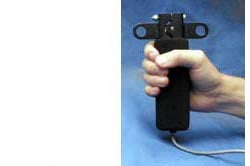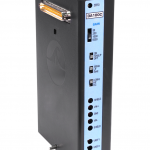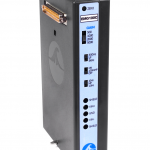The TSD121C can be used for muscle strength studies under isometric constraint:
Hand clench compression measurements
- Grasp the device right under the eyelets; gripping it there will allow one to use a simple multiplicative correction factor to obtain a truer grip reading.
To correct for handle derating:
Create a calculation channel using the expression: A1 * 1.466, where A1 is the analog channel receiving the signal from the TSD121C. This correction assumes that the user is gripping the unit right under the eyelets.
OR
Modify the CAL 2 value to reflect ~80% of the CAL 2 value resulting from the eyelet (tension) method of calibration. This 80% derating suggestion accounts for the shifting of the collective applied force vector—resulting from hand clench—closer to the pivot axis of the TSD121C (near bottom).
Tension measurements
- Thread the attached sturdy metal eye loops using rope or chain.
In this configuration, arm curling, leg lifting and digit activation forces can be measured. For these measurements, one loop is clamped securely and the other loop is attached, via cabling, to the appropriate body location under test.
For in-depth studies of muscular activity, combine TSD121C force recordings with EMG recordings; see the EMG100C amplifier for more information.




Stay Connected